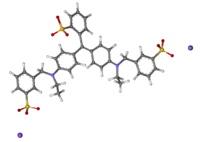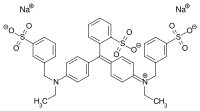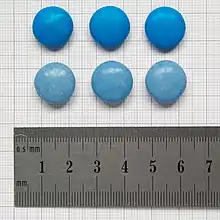亮蓝FCF
亮蓝FCF(蓝色1号)是一种人工合成的有机化合物,主要用作一种蓝色的色素给加工食品、药物、膳食补充剂和化妆品染色。[1]它被分类为一种芳基甲烷染料并且有多个名称,例如FD&C Blue No. 1或者酸性蓝9。它在E编码中被标号为E133并且在国际颜料索引中被标号为42090。在外观上,它是一种可溶于水和甘油的蓝色粉末状固体,[2]具有628纳米的光吸收波长。它是最早被FDA允许的食用色素之一,并且也被广泛认为是无毒无害的。[3]
| 亮蓝FCF | |
|---|---|
 | |
 | |
| IUPAC名 disodium;2-[[4-[ethyl-[(3-sulfonatophenyl)methyl]amino]phenyl]-[4-[ethyl-[(3-sulfonatophenyl)methyl]azaniumylidene]cyclohexa-2,5-dien-1-ylidene]methyl]benzenesulfonate | |
| 别名 | FD&C Blue No.1 Acid blue 9 D&C Blue No. 4 Alzen Food Blue No. 1 Atracid Blue FG Blue #1 Lake Erioglaucine Eriosky blue Patent Blue AR Xylene Blue VSG C.I. 42090, Basacid Blue 755, Sulfacid Brilliant Blue 5 J, Neolan Blue E-A Brilliant Blue FD |
| 识别 | |
| CAS号 | 3844-45-9 |
| PubChem | 19700 |
| ChemSpider | 18556 |
| SMILES |
|
| InChI |
|
| InChIKey | SGHZXLIDFTYFHQ-NUQVWONBAU |
| EINECS | 223-339-8 |
| ChEBI | 82411 |
| KEGG | C19352 |
| 性质 | |
| 化学式 | C37H34N2Na2O9S3 |
| 792.85 g/mol g·mol⁻¹ | |
| 溶解性(水) | 可溶 |
| 危险性 | |
| NFPA 704 |
 1
2
0
|
| 若非注明,所有数据均出自标准状态(25 ℃,100 kPa)下。 | |
生产
亮蓝是一种通过对2-甲酰苯磺酸进行缩合反应,然后和适当的苯胺进行氧化合成的染料[4]。它可以与柠檬黄结合,产生深浅不一的绿色。
该化合物常以二钠盐的形式出现,其CAS号为[],其钙盐和钾盐同样也被允许使用。另外,它也可以以铝色淀的形式出现。二钠盐的化学式为C37H34N2Na2O9S3。
与其相关的染料有C.I.酸性绿 3(CAS号为[])以及酸性绿9 (CAS号[])。在这些染料的分子中,2-磺酸基团被分别替换为氢原子和氯原子。[5]
曾有很多人企图寻找与亮蓝颜色相近且更稳定的天然蓝色染料。可蓝色颜料必须具备很多的化学特征,比如包含π键的形式、芳香环、杂原子和杂环基团、以及离子键等等,以便吸收低能量红光。很多天然蓝色染料都不稳定,蓝色仅仅能产生于碱性条件或者有毒物质存在的条件下;含有花色素苷和臭梧桐碱的衍生物是用于深入研究的良好候选化合物。另外,目前尚未发现任何适合用于饮料的亮蓝替代品。 [6]
.png.webp)
应用
.jpg.webp)
像许多其他的食用色素一样,主要使用的亮蓝是用于改正或增强天然着色剂,或者使得无色的化合物产生一种鲜明的颜色[7]。
在美国,有两种允许使用的蓝色染料(一种是亮蓝,另外一种是靛蓝胭脂红,或者叫FD&C蓝色2号),其中,亮蓝的使用最普遍。作为一种蓝色染料,亮蓝经常被使用于棉花糖、冰淇淋、罐装食品以及加工豆类、袋装汤品、瓶装食用色素、甜筒、冰棒、蓝莓味的食品、儿童药物、日用品、糖果[8]、饮料,尤其是蓝色库拉索酒。它同样用于肥皂、洗发水和漱口水[9],以及其他卫生和化妆品应用。
亮蓝也被广泛用作一种水示踪剂[10]。由于其可以长期保留颜色的能力,亮蓝表现得比其他染料示踪剂更好。另外,亮蓝毒性低,因此对环境有利。然而,亮蓝对不同的土壤有不同的影响。亮蓝更容易被酸性土壤吸收,由于其分子很大且有离子键。土壤成分和流速也会影响亮蓝的吸附水平[11]。
大多数饮料含有亮蓝,比如苏打水,它也被用于蓝瓶实验。在这样的饮料中,染料和还原剂都被混合在同样的溶液中。当溶液呈蓝色时,存在氧气。如果加入氢氧化钠,发生了一种除去氧气的反应,使得溶液变得无色。染料回到蓝色状态时,可以通过旋转溶液使其再次氧化,空气中的氧气作为氧化剂进入到溶液当中[12]。
健康和安全性

这种染料很难被胃肠道吸收,所以摄入染料的95% 都可以在粪便中找到。当被涂抹在舌头或刮过的皮肤上时,亮蓝会被直接吸收进血液[13]。
由于其无毒的性质,亮蓝被用作生物着色剂。当其溶解于介质中时,被用于给细胞壁、细菌以及真菌细胞染色。另外,这种染料不会抑制任何物种的发育[14]。因为同样的理由,亮蓝也被应用在与凝血有关的医疗设备中。将低浓度以1cm的增量的亮蓝置于血贴的背面,以允许外科医生精确切割并指示作为有效止血剂的血贴的一侧,以便正确放置[15]。
另外,其亦为是欧盟和美国批准用于药物配方的食品着色剂和无药理活性物质,在其他国家也同样合法。但是,它具有在患有中度哮喘的个体中诱导过敏反应的能力[16]。2003 年,美国FDA发布了一项公共卫生咨询,以警告医疗保健用品提供者这种合成染料在肠内喂养溶液中的潜在毒性[17]。 以下对于该染料的法律限制适用于欧盟和其他国家/地区:150–300mg/kg,具体取决于食品类型;食品和药品的安全限量为0.1mg/日/体重(kg)[18]。 亮蓝的一日可接受攝取量为6mg/kg。
生物学研究
亮蓝FCF及其相似的染料,比如亮蓝G,均为嘌呤受体——即引起发炎反应和细胞进程的受体——的阻滞剂。[19]
Scientists who were conducting in-vivo studies of compounds to lessen the severity of inflammation following experimental spinal cord injury had previously tested a compound called OxATP to block a key ATP receptor in spinal neurons. However, OxATP has toxic side effects and must be injected directly into the spinal cord; in searching for alternatives they noted that brilliant blue FCF has a similar structure. This led them to test a related dye, brilliant blue G (also known as Coomassie brilliant blue) in rats, which improved recovery from spinal cord injury while temporarily turning them blue.[20]
When human washed platelets are evaluated using turbidimetry it was found that brilliant blue FCF affects platelet aggregation by blocking the Panx1 channels. These inhibitory effects on collagen-induced shape change and maximal aggregation were shown by high (1 mM) concentrations of the dye but not by lower concentrations (100 μM). The 1 mM effective concentration is 1.59 times greater than the approximately 0.63 mM maximal allowable brilliant blue FCF concentration according to the European Food Safety Authority.[21]
Scientists are performing studies to better understand the effects of brilliant blue FCF during vein graft explantation. Brilliant blue FCF hinders the purinergic receptors, limiting cell proliferation that may lead to intimal hyperplasia. The effects of brilliant blue FCF were tested on rat aortic cells. It was found that brilliant blue FCF had a positive impact in limiting the development of intimal hyperplasia following a vein graft procedure.[22][23]
引用
- . International Association of Color Manufacturers. [2019-05-06]. (原始内容存档于2019-05-06).
- . culinarylore.com. 2015-08-04 [2019-06-03]. (原始内容存档于2021-08-24).
- Nutrition, Center for Food Safety and Applied. . FDA. 2019-03-16 [2019-05-06]. (原始内容存档于2021-08-24).
- El Ali, Bassam M.; Bassam El Ali; Ali, Mohammad Farahat.
 . New York: McGraw-Hill. 2005. ISBN 978-0-07-141037-3.
. New York: McGraw-Hill. 2005. ISBN 978-0-07-141037-3. - Gessner T, Mayer U. . . Weinheim: Wiley-VCH. 2002. ISBN 3527306730. doi:10.1002/14356007.a27_179.
- Newsome, Andrew G.; Culver, Catherine A.; van Breemen, Richard B. . Journal of Agricultural and Food Chemistry. 2014-07-16, 62 (28): 6498–6511. ISSN 0021-8561. PMID 24930897. doi:10.1021/jf501419q.
- Nutrition, Center for Food Safety and Applied. . FDA. 2019-04-14 [2022-02-26]. (原始内容存档于2022-07-10) (英语).
- Nestle Aero packet ingredients listing barcode: 7613031579334
- . Listerine.com. [2009-07-31]. (原始内容存档于2011-01-02).
- Flury M, Flühler H. . Journal of Environmental Quality. 1994, 23 (5): 1108–1112. doi:10.2134/jeq1994.00472425002300050037x.
- Allaire SE, Roulier S, Cessna AJ. . Journal of Hydrology. 2009-11-15, 378 (1): 179–204. Bibcode:2009JHyd..378..179A. doi:10.1016/j.jhydrol.2009.08.013.
- Staiger FA, Peterson JP, Campbell DJ. . Journal of Chemical Education. 2015-10-13, 92 (10): 1684–1686. Bibcode:2015JChEd..92.1684S. doi:10.1021/acs.jchemed.5b00190.
- Lucová M, Hojerová J, Pažoureková S, Klimová Z. . Food and Chemical Toxicology. February 2013, 52: 19–27. PMID 23127598. doi:10.1016/j.fct.2012.10.027.
porcine tongue dorsum was exposed to human saliva with 15,000 ng/cm2 of dye for 20 min. 24-h diffusion resulted in 34 ng/cm2 of BB and 86 ng/cm2 of PB which can be directly absorbed into the blood system.
- Chau HW, Goh YK, Si BC, Vujanovic V. . Biotechnic & Histochemistry. August 2011, 86 (4): 280–7. PMID 20560873. S2CID 37175297. doi:10.3109/10520295.2010.492733.
- Lewis KM, Kuntze CE, Gulle H. . Medical Devices: Evidence and Research. 2015-12-22, 9: 1–10. PMC 4694675
 . PMID 26730213. doi:10.2147/mder.s90591 (英语).
. PMID 26730213. doi:10.2147/mder.s90591 (英语). - Weber RW, Hoffman M, Raine DA, Nelson HS. . The Journal of Allergy and Clinical Immunology. July 1979, 64 (1): 32–7. PMID 447949. doi:10.1016/0091-6749(79)90080-0.
- . Drugs.com. [16 November 2013]. (原始内容存档于2021-08-24).
- . zusatzstoffe-online.de. [2013-11-16]. (原始内容存档于2013-05-27).
- Ferreira LG, Faria RX, Ferreira NC, Soares-Bezerra RJ. . International Journal of Food Science. 2016, 2016: 7548498. PMC 5090090
 . PMID 27833914. doi:10.1155/2016/7548498
. PMID 27833914. doi:10.1155/2016/7548498  .
. - Peng W, Cotrina ML, Han X, Yu H, Bekar L, Blum L, Takano T, Tian GF, Goldman SA, Nedergaard M. . Proceedings of the National Academy of Sciences of the United States of America. July 2009, 106 (30): 12489–93. PMC 2718350
 . PMID 19666625. doi:10.1073/pnas.0902531106
. PMID 19666625. doi:10.1073/pnas.0902531106  .
. - Molica F, Nolli S, Fontana P, Kwak BR. . Journal of Visualized Experiments. April 2017, (122). PMC 5564473
 . PMID 28448011. doi:10.3791/55525.
. PMID 28448011. doi:10.3791/55525. - Osgood MJ, Sexton K, Voskresensky I, Hocking K, Song J, Komalavilas P, Brophy C, Cheung-Flynn J. . Journal of Vascular Surgery. August 2016, 64 (2): 471–478. PMC 5480606
 . PMID 27763268. doi:10.1016/j.jvs.2015.02.028.
. PMID 27763268. doi:10.1016/j.jvs.2015.02.028. - Voskresensky, Igor V.; Wise, Eric S.; Hocking, Kyle M.; Li, Fan Dong; Osgood, Michael J.; Komalavilas, Padmini; Brophy, Colleen; Cheung-Flynn, Joyce. . JAMA Surgery. 2014-11-01, 149 (11): 1176–81. ISSN 2168-6254. PMC 4237645
 . PMID 25251505. doi:10.1001/jamasurg.2014.2029.
. PMID 25251505. doi:10.1001/jamasurg.2014.2029.
补充阅读
- Hansen WH, Fitzhugh OG, Nelson AA, Davis KJ. . Toxicology and Applied Pharmacology. January 1966, 8 (1): 29–36. PMID 5950860. doi:10.1016/0041-008X(66)90097-4.
- Borzelleca JF, Depukat K, Hallagan JB. . Food and Chemical Toxicology. April 1990, 28 (4): 221–34. PMID 2358248. doi:10.1016/0278-6915(90)90034-K.
- Brown JP, Dorsky A, Enderlin FE, Hale RL, Wright VA, Parkinson TM. . Food and Cosmetics Toxicology. February 1980, 18 (1): 1–5. PMID 7372204. doi:10.1016/0015-6264(80)90002-4.